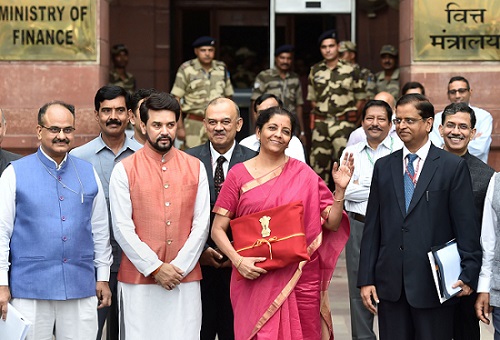
This budget is unique. Beyond numbers, the underlying current is an overwhelming vision to change the direction of economy, towards virtuous and qualitative economic growth.
Focus is to activate ‘virtuous-spiral’ of economic-growth – the “shubh-labh” as stipulated in ancient Bhartiya culture, as opposed to the domination of ‘easy-money’. This deserves the highest commendation by one and all. And the means identified to achieve this goal, is “entrepreneurial-drive”, which if correctly implemented, would be revolutionary and transformational. Looking back, the first four decades of Independent India as entrepreneur-killing license-raj (1947-1991), and the past five decades (1970-till about 2014) as gradually corrupting society, this year’s budget brings a fresh breeze, calling upon the nation to move towards an honest-and-entrepreneurial-era.
What is remarkable is that the Finance Minister Nirmala Sitharaman did not miss the importance of grass-root level initiatives. For instance, the provision of Rs 5,000/- overdraft facility for a rural woman in self-help-group and the plan to create 75,000 skilled rural entrepreneurs in agro-rural industry are noteworthy. The Finance Minister (FM) has also simultaneously referred to empowering social entrepreneurs, start-ups, private-public partnerships and high-tech space-ventures, among others. Moreover, the research-drive for high-tech and sustainable technologies, can open doors for innovative talents as the way ahead.
Nurturing entrepreneurs and creativity at all stages is the real basis to growth of virtuous-spiral of wealth creation, is the key message from the Narayani-FM.
The implementation challenges of ground realities, however, require strategic caution against hijacking of major initiatives by the power brokers, speculative capital and privileges, rather than identifying and advancing genuine entrepreneurs.
Here are a few strategic pointers, in terms of process and systems.
● Rural/Artisan Initiatives It requires careful designing and monitoring by professionals (both in the Organized and the Unorganized), sensitive to local culture without compromising the reliability of quality and delivery. This is where nation can expect double-digit growth and large-scale employment prospects, through value-added rural economy, arresting migration from villages to cities.
● MSME (Micro, Small and Medium Enterprises) Sector The realpain-points are not capital alone, instead, disconnect between old-time entrepreneurs with their new generation. A great number of second generation MSMEs are currently engaged in employment within the larger sector. Furthermore, most opportunities remain untapped, due to neglect in creating domain-specific ecosystems. This is the real backbone of economy, generating maximum employment.
● Private-Public-Partnership (PPP) It has been tried, yet it has not fully succeeded during the past few years. It requires consideration from two specific issues (a) method of resolving conflicts-of-interest, and empowering an honest government officer, to exercise personal discretion in favour of efficient and honest private entities, beyond just lowest bids (b) avoid entry barriers for smaller enterprises having great caliber but not enough capital prowess. These two corrections can result in major gains for Make-in-India in defence, aviation, space, and high-tech sectors, besides infra-structure industries. Correct implementation of strategies may even lead to a reverse brain drain such that talented professionals living abroad may start coming back to country, in decades ahead.
● Social-Enterprises While capital availability and visibility are sure to increase through the SEBI, the institutional supports are warranted in matters of marketing, professional management and availability of high-end knowledge inputs. Attitudinal limitations towards profit making in socially conscientious entrepreneurs require careful moderation to avoid errors in decision making. Or else, these avenues may be hijacked by large scale manipulators or speculators, as is currently happening in the case of tax exempted rich farmers.
● Real-Estate Defining the affordable housing price limit at Rs 45 lakh, misses two crucial aspects (a) speculative increase in land prices of 1000% or even more during the 2004-2014 period across all parts from urban to rural. The market price considered by government agencies are way high in relation to real income levels of 95% of the population. Necessary corrections in land price speculations would automatically make housing affordable for all of society, provided state governments and agencies shed-off their greed for yet another revenue source through artificially jacked-up stamp duties. Central government needs to take lead in correcting market price indications. This one act alone would lead to phenomenal increase in housing economy which is a basic need for all. And, (b) affordable price of land and the housing need are related with specific locations as per type and level of cities or villages.
● Targeting a $5 trillion Economy & Forex-rate Setting the goal in dollar terms reflects a leader’s conviction to compete and succeed in global ranking. Larger purpose alone drives creative entrepreneurs to excel so the goal of $5 trillion economy in 5 years is appropriate. However, it should not be achieved through conventional approach of devaluing rupee to achieve higher exports, for two reasons: (a) firstly, a strong rupee with stronger domestic economy would anyway mean greater in dollar economy (eg. a 20% appreciation in value of rupee in today’s exchange-rate, would appreciate our economy by 20% in dollar terms). So, India needs to opt for forex rates to be set through bilateral arrangements with each nation rather than leaving it to the mercy of speculative currency markets and, (b) India needs to experiment with fixing dual-forex rates, for imports and exports, to achieve higher exports at competitive prices while absorbing difference values in national forex reserves account.
The nation has given a clear mandate to the current government in recent general elections with a hope for better times ahead. Faith posed in honest and decisive leadership is reflected in the tone and spirit of this budget. However, the challenge lies in building knowledge teams that can clearly visualise nut-bolt detailing and potential pitfalls so the implementation may actually lead society as a whole towards ascending prosperity during the next five years.
